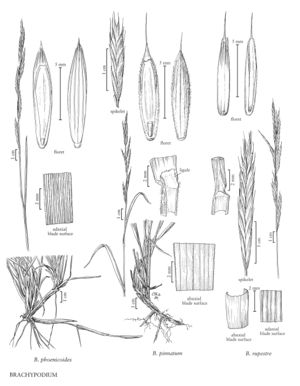Difference between revisions of "Brachypodium rupestre"
FNA>Volume Importer |
FNA>Volume Importer |
||
| Line 7: | Line 7: | ||
|synonyms={{Treatment/ID/Synonym | |synonyms={{Treatment/ID/Synonym | ||
|name=Brachypodium cespitosum | |name=Brachypodium cespitosum | ||
| − | |authority= | + | |authority= |
| + | |rank=species | ||
}} | }} | ||
|hierarchy=Poaceae;Poaceae subfam. Pooideae;Poaceae tribe Brachypodieae;Brachypodium;Brachypodium rupestre | |hierarchy=Poaceae;Poaceae subfam. Pooideae;Poaceae tribe Brachypodieae;Brachypodium;Brachypodium rupestre | ||
| Line 20: | Line 21: | ||
-->{{Treatment/Body | -->{{Treatment/Body | ||
|distribution=Calif. | |distribution=Calif. | ||
| − | |discussion=<p>Brachypodium rupestre is native to Europe and northern Turkey; it is not known to be established in the Flora region. Specimens of this species were grown by the Natural Resources Conservation Service in Pima County, Arizona and Bernalillo County, New Mexico; they were distributed either as Brachypodium sp. or as B. cespitosum (Host) Roem. & Schult. The description is based on Schippmann (1991).</p> | + | |discussion=<p><i>Brachypodium rupestre</i> is native to Europe and northern Turkey; it is not known to be established in the Flora region. Specimens of this species were grown by the Natural Resources Conservation Service in Pima County, Arizona and Bernalillo County, New Mexico; they were distributed either as <i>Brachypodium</i> sp. or as B. cespitosum (Host) Roem. & Schult. The description is based on Schippmann (1991).</p> |
|tables= | |tables= | ||
|references= | |references= | ||
| Line 29: | Line 30: | ||
-->{{#Taxon: | -->{{#Taxon: | ||
name=Brachypodium rupestre | name=Brachypodium rupestre | ||
| − | |||
|authority=(Host) Roem. & Schult. | |authority=(Host) Roem. & Schult. | ||
|rank=species | |rank=species | ||
| Line 36: | Line 36: | ||
|basionyms= | |basionyms= | ||
|family=Poaceae | |family=Poaceae | ||
| − | |illustrator=Cindy Roché | + | |illustrator=Cindy Roché;Annaliese Miller |
| + | |illustration copyright=Utah State University | ||
|distribution=Calif. | |distribution=Calif. | ||
|reference=None | |reference=None | ||
| Line 42: | Line 43: | ||
|publication year= | |publication year= | ||
|special status= | |special status= | ||
| − | |source xml=https:// | + | |source xml=https://jpend@bitbucket.org/aafc-mbb/fna-data-curation.git/src/f50eec43f223ca0e34566be0b046453a0960e173/coarse_grained_fna_xml/V24/V24_262.xml |
|subfamily=Poaceae subfam. Pooideae | |subfamily=Poaceae subfam. Pooideae | ||
|tribe=Poaceae tribe Brachypodieae | |tribe=Poaceae tribe Brachypodieae | ||
Revision as of 20:19, 16 December 2019
Plants perennial; cespitose, shortly rhizomatous. Culms 30-95(125) cm tall, 0.5-0.8 mm thick, narrowed below the racemes; nodes pubescent. Sheaths glabrous or hairy; ligules 0.4-2.4 mm, truncate; blades (9)15-40(52) cm long, 2.5-6.5(9) mm wide, stiff, involute or flat, light green, abaxial surfaces smooth or almost so, glabrous, conspicuously shiny, adaxial surfaces somewhat scabridulous, primary veins conspicuous, separated by finer secondary veins. Racemes (4)10-30(40) cm, with 5-9(12) spikelets. Spikelets (14)20-33(46) mm, terete or subterete, usually glabrous, with (7)10-17(24) florets; pedicels 0.6-2(3) mm. Glumes unequal, less than 1/3 the length of the spikelets, lanceolate, mucronate; lower glumes 4-8.5 mm, 3-6-veined; upper glumes 5.5-10.5 mm, 6-7-veined; lemmas 7-10.5(12) mm, lanceolate, 5-7-veined, awned, awns (2)3-10 mm; lodicules lanceolate, apices hairy, hairs stiff; anthers about 6 mm. Caryopses 5-7 mm. 2n = 14, 18, 28, 36.
Discussion
Brachypodium rupestre is native to Europe and northern Turkey; it is not known to be established in the Flora region. Specimens of this species were grown by the Natural Resources Conservation Service in Pima County, Arizona and Bernalillo County, New Mexico; they were distributed either as Brachypodium sp. or as B. cespitosum (Host) Roem. & Schult. The description is based on Schippmann (1991).
Selected References
None.
